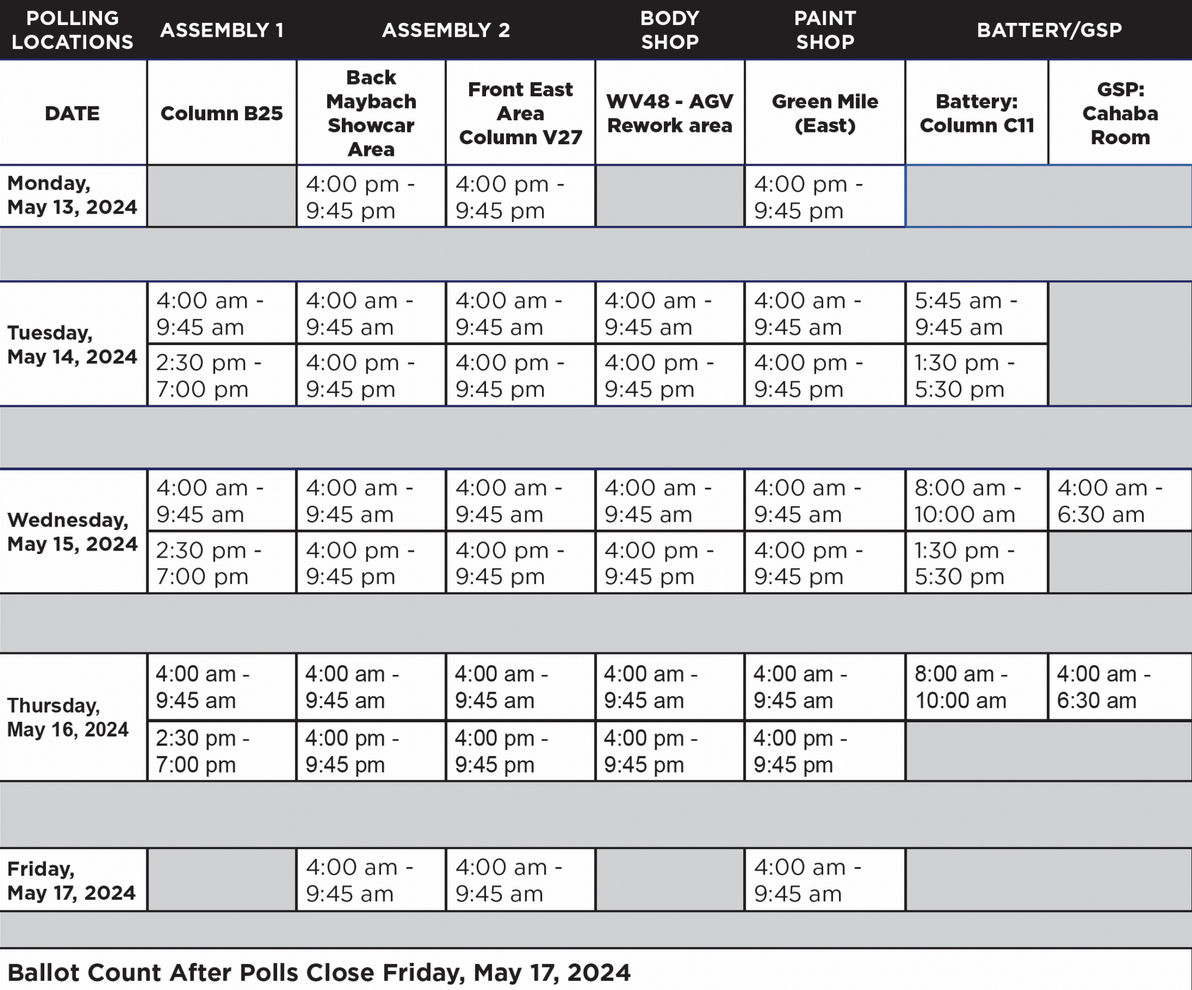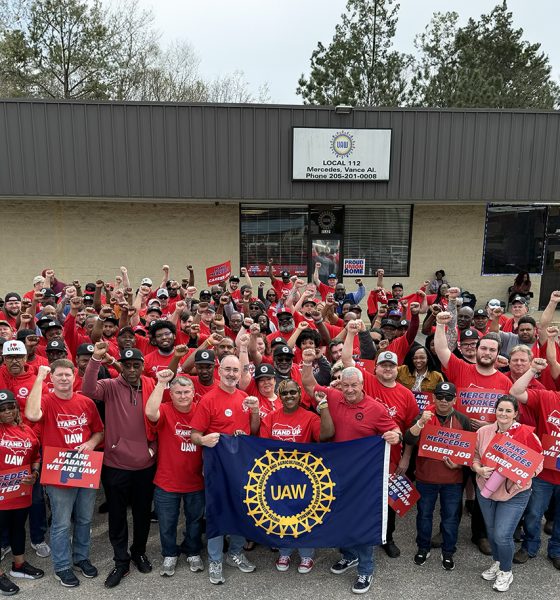Mercedes-Benz workers at a factory in Alabama have begun voting on whether to join the United Auto Workers (UAW) this week, after the union was voted in at a Volkswagen plant in Tennessee a few weeks ago.
On Monday, Mercedes workers began voting on UAW membership at the company’s factory in Tuscaloosa, Alabama, with voting remaining open until Friday. The vote comes after a majority of workers at the Mercedes plant in February voted to hold a union vote, and after Volkswagen employees officially voted to recognize the UAW at the company’s factory in Chattanooga, Tennessee, last month.
The Mercedes vote is thought to be much less of a sure-fire victory for the union, especially with the automaker specifically telling workers that they should vote no through flyers and signage, as Reuters reports. The outlet also alleges that Mercedes hired anti-union companies to come speak at the plant, though the automaker has denied that it is using union-busting tactics at the factory.
“Mercedes-Benz U.S. International (MBUSI) fully respects our Team Members’ choice whether to unionize and we look forward to participating in the election process to ensure every Team Member has a chance to cast their own secret-ballot vote, as well as having access to the information necessary to make an informed choice,” a Mercedes spokesperson told Teslarati in an email.
“MBUSI has a strong record of success over the past 25+ years operating as One Team in Alabama. Our primary focus at MBUSI is always to provide a safe and supportive work environment for our Team Members, so they can continue to build safe and superior vehicles for the world. We believe open and direct communication with our Team Members is the best path forward to ensure continued success.”
Below, you can see the voting schedule for workers at the Mercedes factory, with the ballots set to be counted after polls close on Friday morning.
Credit: UAW
A spokesperson from the company told Reuters that Mercedes-Benz respects worker unionization efforts, adding that the company is making sure that each worker can vote secretly, while having all the details necessary to cast an informed vote.
“That is the biggest thing that we’re using to push because we can show how much the union can win now,” Mercedes employee Jacob Ryan told Reuters. Ryan adds that he supports the union due to the automaker’s failure to address worker concerns such as pay, hours, and benefits.
The employee has been at the factory for around five years, and under two years ago, he witnessed the plant struggling to get 20 percent of workers to file for a union election. To reach the point of holding a National Labor Relations Board (NLRB) election, as is now happening, the UAW says it waits for a facility to reach a 70-percent threshold of workers filing in favor of a vote.
The Alabama Mercedes plant produces the electric EQS and EQE lineups, as well as the gas GLE and GLS vehicles, according to the company’s website. The automaker also says it employed 6,100 workers in 2023, with around 295,000 vehicles produced there in the same year.
Although the Volkswagen plant had voted not to be recognized by the UAW twice before voting to join the union last month, this is the first time that a union election has been held at the Tuscaloosa Mercedes factory.
Following the UAW’s historic six-week strikes of Ford, General Motors (GM), and Stellantis last year, which ultimately garnered record pay increases for workers, the union announced a campaign at several other non-unionized facilities. In addition to Volkswagen and Mercedes, the UAW announced plans to launch organizing efforts at Tesla, Rivian, and nine other automakers.
During the strikes, UAW President Shawn Fain also called employees at Tesla, Toyota and other automakers “members of the future,” later saying he hoped to bargain with the “Big Five or Six” in 2028, rather than just the Big Three.
What are your thoughts? Let me know at zach@teslarati.com, find me on X at @zacharyvisconti, or send us tips at tips@teslarati.com.

News
Tesla starts showing how FSD will change lives in Europe
Local officials tested the system on narrow country roads and were impressed by FSD’s smooth, human-like driving, with some calling the service a game-changer for everyday life in areas that are far from urban centers.

Tesla has launched Europe’s first public shuttle service using Full Self-Driving (Supervised) in the rural Eifelkreis Bitburg-Prüm region of Germany, demonstrating how the technology can restore independence and mobility for people who struggle with limited transport options.
Local officials tested the system on narrow country roads and were impressed by FSD’s smooth, human-like driving, with some calling the service a game-changer for everyday life in areas that are far from urban centers.
Officials see real impact on rural residents
Arzfeld Mayor Johannes Kuhl and District Administrator Andreas Kruppert personally tested the Tesla shuttle service. This allowed them to see just how well FSD navigated winding lanes and rural roads confidently. Kruppert said, “Autonomous driving sounds like science fiction to many, but we simply see here that it works totally well in rural regions too.” Kuhl, for his part, also noted that FSD “feels like a very experienced driver.”
The pilot complements the area’s “Citizen Bus” program, which provides on-demand rides for elderly residents who can no longer drive themselves. Tesla Europe shared a video of a demonstration of the service, highlighting how FSD gives people their freedom back, even in places where public transport is not as prevalent.
What the Ministry for Economic Affairs and Transport says
Rhineland-Palatinate’s Minister Daniela Schmitt supported the project, praising the collaboration that made this “first of its kind in Europe” possible. As per the ministry, the rural rollout for the service shows FSD’s potential beyond major cities, and it delivers tangible benefits like grocery runs, doctor visits, and social connections for isolated residents.
“Reliable and flexible mobility is especially vital in rural areas. With the launch of a shuttle service using self-driving vehicles (FSD supervised) by Tesla in the Eifelkreis Bitburg-Prüm, an innovative pilot project is now getting underway that complements local community bus services. It is the first project of its kind in Europe.
“The result is a real gain for rural mobility: greater accessibility, more flexibility and tangible benefits for everyday life. A strong signal for innovation, cooperation and future-oriented mobility beyond urban centers,” the ministry wrote in a LinkedIn post.
News
Tesla China quietly posts Robotaxi-related job listing
Tesla China is currently seeking a Low Voltage Electrical Engineer to work on circuit board design for the company’s autonomous vehicles.

Tesla has posted a new job listing in Shanghai explicitly tied to its Robotaxi program, fueling speculation that the company is preparing to launch its dedicated autonomous ride-hailing service in China.
As noted in the listing, Tesla China is currently seeking a Low Voltage Electrical Engineer to work on circuit board design for the company’s autonomous vehicles.
Robotaxi-specific role
The listing, which was shared on social media platform X by industry watcher @tslaming, suggested that Tesla China is looking to fill the role urgently. The job listing itself specifically mentions that the person hired for the role will be working on the Low Voltage Hardware team, which would design the circuit boards that would serve as the nervous system of the Robotaxi.
Key tasks for the role, as indicated in the job listing, include collaboration with PCB layout, firmware, mechanical, program management, and validation teams, among other responsibilities. The role is based in Shanghai.
China Robotaxi launch
China represents a massive potential market for robotaxis, with its dense urban centers and supportive policies in select cities. Tesla has limited permission to roll out FSD in the country, though despite this, its vehicles have been hailed as among the best in the market when it comes to autonomous features. So far, at least, it appears that China supports Tesla’s FSD and Robotaxi rollout.
This was hinted at in November, when Tesla brought the Cybercab to the 8th China International Import Expo (CIIE) in Shanghai, marking the first time that the autonomous two-seater was brought to the Asia-Pacific region. The vehicle, despite not having a release date in China, received a significant amount of interest among the event’s attendees.
Elon Musk
Elon Musk and Tesla AI Director share insights after empty driver seat Robotaxi rides
The executives’ unoccupied tests hint at the rapid progress of Tesla’s unsupervised Robotaxi efforts.

Tesla CEO Elon Musk and AI Director Ashok Elluswamy celebrated Christmas Eve by sharing personal experiences with Robotaxi vehicles that had no safety monitor or occupant in the driver’s seat. Musk described the system’s “perfect driving” around Austin, while Elluswamy posted video from the back seat, calling it “an amazing experience.”
The executives’ unoccupied tests hint at the rapid progress of Tesla’s unsupervised Robotaxi efforts.
Elon and Ashok’s firsthand Robotaxi insights
Prior to Musk and the Tesla AI Director’s posts, sightings of unmanned Teslas navigating public roads were widely shared on social media. One such vehicle was spotted in Austin, Texas, which Elon Musk acknowleged by stating that “Testing is underway with no occupants in the car.”
Based on his Christmas Eve post, Musk seemed to have tested an unmanned Tesla himself. “A Tesla with no safety monitor in the car and me sitting in the passenger seat took me all around Austin on Sunday with perfect driving,” Musk wrote in his post.
Elluswamy responded with a 2-minute video showing himself in the rear of an unmanned Tesla. The video featured the vehicle’s empty front seats, as well as its smooth handling through real-world traffic. He captioned his video with the words, “It’s an amazing experience!”
Towards Unsupervised operations
During an xAI Hackathon earlier this month, Elon Musk mentioned that Tesla owed be removing Safety Monitors from its Robotaxis in Austin in just three weeks. “Unsupervised is pretty much solved at this point. So there will be Tesla Robotaxis operating in Austin with no one in them. Not even anyone in the passenger seat in about three weeks,” he said. Musk echoed similar estimates at the 2025 Annual Shareholder Meeting and the Q3 2025 earnings call.
Considering the insights that were posted Musk and Elluswamy, it does appear that Tesla is working hard towards operating its Robotaxis with no safety monitors. This is quite impressive considering that the service was launched just earlier this year.










